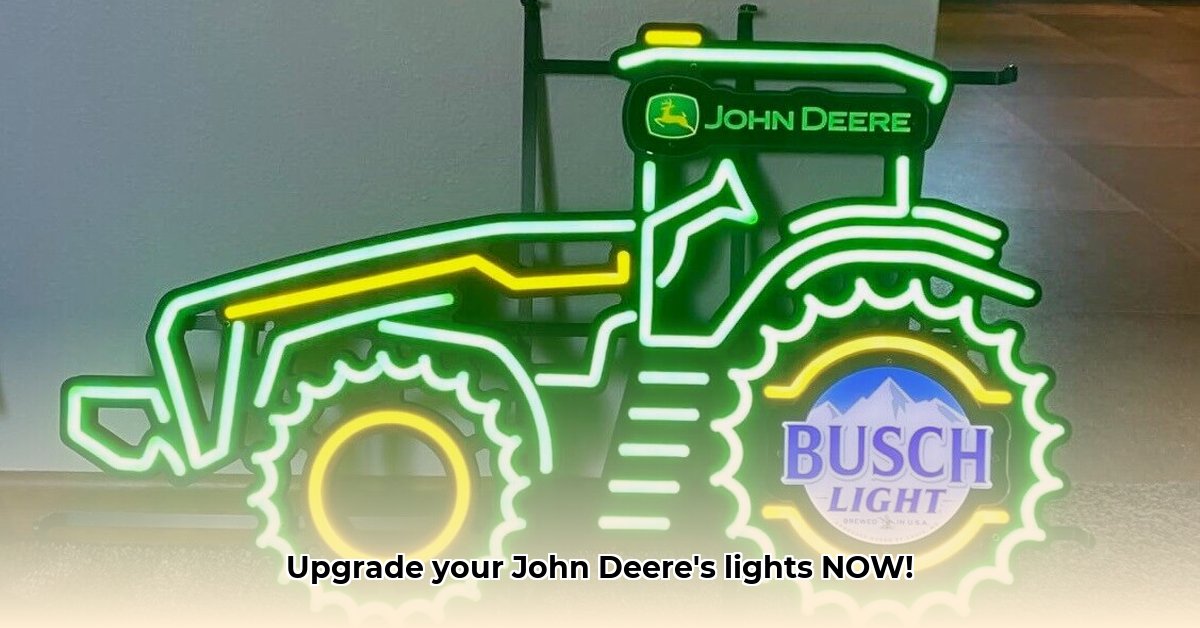
John Deere Tractor Lamp Market Overview: A Bright Future
Shining a light on the subject of tractor lighting may seem trivial, but for farmers, effective illumination is paramount. Poor lighting contributes to significant safety risks and reduced productivity, especially during extended working hours. This comprehensive upgrade guide illuminates the world of John Deere tractor lamps, empowering you to make informed decisions to enhance safety and efficiency. Our analysis reveals a surprisingly high demand for replacement and supplemental tractor lighting for John Deere equipment. Online marketplaces showcase thousands of listings, indicating a significant market beyond what John Deere directly supplies. This high demand suggests opportunities for both aftermarket suppliers and John Deere itself. While data limitations prevent precise identification of the most popular lamp types, the overall volume highlights a genuine need for improved lighting solutions. Regional variations likely exist; farmers in areas with long working hours or harsh weather conditions may prioritize more powerful and durable lights. For more information, check out this helpful resource: John Deere Tractor Lights. Isn't it time you upgraded your lighting system?
Types of John Deere Tractor Lamps: Beyond Headlights
John Deere tractors utilize a variety of lighting components, each serving a specific purpose. Headlights provide primary illumination for general visibility, while work lights offer focused beams for specific tasks such as repair or nighttime fieldwork. Specialized lamps, including backup lights, marker lights, and application-specific lights, further enhance functionality and safety. Understanding the unique function of each lamp type is crucial when selecting replacements or additions. The rise of LED technology represents a significant advancement in tractor lighting. LED lamps offer several key advantages over traditional incandescent bulbs: longer lifespan, increased brightness, reduced energy consumption, and improved durability. The more compact nature of LEDs also proves beneficial when adding extra lights in space-constrained areas.
Choosing the Right John Deere Tractor Lamp Replacement: A Practical Guide
Selecting the right replacement lamps can be daunting. This straightforward, step-by-step guide streamlines the process:
Step 1: Assess Your Needs: What type of lighting is required? Do you mainly operate at night? Do you need exceptionally bright work lights? Define your budget and prioritize features based on your specific needs.
Step 2: Verify Compatibility: This step is crucial. Ensure the lamp is compatible with your specific John Deere tractor model. Consult your tractor's manual or the John Deere parts website for compatible parts. Using incorrect lamps can lead to malfunction and pose safety hazards.
Step 3: Prioritize Quality: While cost-effective options are appealing, investing in high-quality lamps is economically sound in the long run. Counterfeit parts pose significant risks, often exhibiting poor performance and potential safety hazards. Look for reputable brands and warranties as indicators of reliable products. Do you want to risk your safety on a cheap lamp?
Step 4: Leverage Online Reviews: Online reviews from fellow farmers provide invaluable insights into real-world performance, durability, and longevity. Pay close attention to comments about brightness, longevity, and overall satisfaction.
Here's a comparative analysis emphasizing the benefits of investing in high-quality lamps:
| Feature | High-Quality Lamp | Low-Quality Lamp |
|---|---|---|
| Brightness | Powerful, consistent illumination | Dim, flickering, uneven illumination |
| Durability | Robust construction; resists damage | Fragile; prone to breakage |
| Lifespan | Extended operational lifespan | Short lifespan; frequent replacements needed |
| Warranty | Comprehensive warranty; readily accessible support | Limited or no warranty; challenging support access |
| Price | Higher upfront cost, lower long-term expense | Lower upfront cost, higher long-term expense |
Maintaining Your John Deere Tractor Lights: Tips for Extended Lifespan
Prolonging the life of your tractor lamps is straightforward. Regular cleaning and preventative maintenance significantly extend their operational lifespan. Routine cleaning removes accumulated dirt and debris, improving illumination and visibility. Promptly replace damaged or cracked lenses to prevent further damage and maintain optimal operational safety. Consider sealing your lights to prevent corrosion and moisture damage, especially in harsh weather conditions and high humidity environments. What's the cost of neglecting preventive maintenance?
Stakeholder Perspectives: Shaping the Future of Tractor Lighting
Aftermarket Suppliers: Focus on high-demand products. Prioritize quality control to minimize counterfeit issues and build brand trust. Long-term strategies should center on innovation, particularly the development of advanced LED solutions which surpass existing options.
John Deere (OEM): Monitor aftermarket trends to inform pricing and product design choices. Investing in R&D for enhanced lighting technologies is vital to maintain competitiveness and fulfill evolving farmer needs. Ignoring market trends could be a costly mistake.
Farmers: Prioritize safety and efficiency. While the initial cost of high-quality lamps might seem higher, the extended lifespan and improved performance typically translate to long-term savings. Consider energy-efficient options, such as LEDs, to reduce operational costs. Isn't your safety and success worth the investment?
Conclusion: Illuminate Your Success
Well-maintained lighting on your John Deere tractor is crucial for safety and productivity. Informed decisions regarding tractor lighting are crucial and will significantly affect your farming operation's profitability. Continuous research into advancements in lighting technology remains vital for optimizing efficiency and safety.